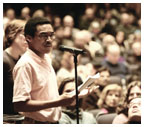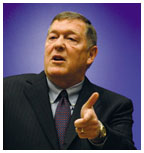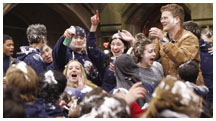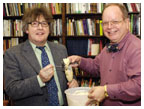
|
March 8, 2006: Notebook
Debate simmers over invitations to speak on campus
Deconstructing Greenspan
Professors analyze longtime Fed leader’s record of success
Butler dorms to be razed, replaced
New filings in Robertson lawsuit attract flurry of news coverage
Welcome, new club members After visiting the rooms of newly admitted members
Debate simmers over invitations to speak on campus
Milton Wilkins ’09 speaks at a forum about guest speakers. (John Jameson ’04) |
More than 400 people turned out Feb. 7 for a lively and often tense forum that questioned the selection of campus speakers and what kind of dialogue with them is appropriate.
The student-organized forum, “Intellectuals and the Institution,” continued a discussion that has been simmering since last fall, when the Woodrow Wilson School’s 75th anniversary celebration featured several government and military officials, including Secretary of State Condoleezza Rice. After the event, 128 students and faculty members signed a letter to the Daily Princetonian, criticizing the University for a “trend” of inviting to campus guest speakers who spoke for the Bush administration.
One forum organizer, Fernando Montero ’06, said the students “oppose the persistent exclusion” of speakers who are unaffiliated with either party in government, and that there is “not meaningful interaction between speakers, faculty, and students.” (For an interview with Montero, see page 72.) Students and faculty were particularly distressed, he said, by remarks made by Woodrow Wilson School Dean Anne-Marie Slaughter ’80 at Rice’s keynote address, when Slaughter said the secretary “exemplifies” the University’s values.
Montero also criticized Slaughter’s introduction of another keynote speaker, Lt. Gen. David Petraeus *87, the former head of the Multi-National Security Transition Command in Iraq. In that instance, Slaughter joked that Petraeus responded to her invitation to speak by sending an e-mail at 4:30 a.m. during the battle at Fallujah; Montero said this made light of the suffering that was taking place.
Slaughter, one of three panelists, defended the school’s record of bringing speakers of all views, noting several critics of government who have lectured recently. She said the Wilson School unsuccessfully had attempted to schedule speakers with different views for the anniversary. “If you look overall at whom we invite, it is a very broad spectrum, and we want it that way,” said Slaughter, who has expressed harsh views of the Bush administration’s foreign policy in her own writing.
She said her remarks about Rice referred to the secretary’s career, not her policies. Rice “took her expertise in the academy and put it into service in government,” a Princeton value, Slaughter said, adding, “Inviting someone does not involve endorsing their policy.” But she said the forum did give her a better understanding of how her remarks about Rice and Petraeus came across.
The other two panelists were religion professor Cornel West *80, who had signed the letter of protest; and Mark Bruzonsky *73, founder of an Internet site called Mid-East Realities. Bruzonsky called for an independent, student-run organization to bring a broader spectrum of “world-class, independent scholars and journalists” to campus. “At the 75th anniversary, everyone was force-fed a steady diet of top political personalities,” he said. “This is not, in my view, in the nation’s service. And it’s certainly not in the service of all nations.”
The exchange got nasty when Bruzonsky accused Slaughter of “using the University as a stepping-stone to personal and political power” and pointedly asked whether she intended to seek a government post. Later in the forum, Slaughter responded that she felt the question was inappropriate because “the accusation there is not about ambition; it’s about integrity.” But she noted that she encourages students to go into government service — and that, at some point, she hoped to do so herself. “There is no shame in saying you want to serve the nation in any way,” she said.
West generally stayed out of the fray, while calling for more student interaction and “Socratic activity” when speakers visit: “If you want to spew your propaganda, go on talk radio.”
After the forum, Syon Bhanot ’06, a Woodrow Wilson School major,
disagreed with Bruzonsky’s claim that few independent speakers visit
campus. Bhanot cited a December speech by Philip Gourevitch, a journalist
who broke important stories about the Rwandan genocide. Bhanot added that
only a few students attended the event. ![]()
By Elyse Graham ’07

Alan Blinder ’67
Ricardo Reis (photos courtesy Alan Blinder ’67; Jose Cardigos and Ricardo Reis) |
Deconstructing
Greenspan
Professors analyze longtime Fed leader’s record of success
In February, former Princeton professor Ben Bernanke became chairman of the Federal Reserve, taking the reins from 18-year veteran Alan Greenspan. While Greenspan’s record was extraordinary, his methods remain largely unknown, according to Professor Alan Blinder ’67, who served as the vice chairman of the Federal Reserve Board of Governors from 1994–96, and Ricardo Reis, an assistant professor of economics and public affairs. Blinder and Reis, who presented a paper about Greenspan’s term at a Federal Reserve Bank of Kansas City symposium last August, spoke with PAW’s Brett Tomlinson about the outgoing chairman’s legacy and the future of the Fed.
In your paper, you said that Greenspan “has a legitimate claim to being the greatest central banker who ever lived.” What sets him apart?
AB: Some of it is the style. But in addition to that, it’s his incredible longevity — he was by far the most senior central banker in the world — and also the success of that period. There are several metrics of this success, but one very obvious one is the near-absence of recessions in the Greenspan era. I would count it as one recession and one recession-ette. ... That’s very little in 18 1/2 years.
RR: And at the same time, inflation has been very low. He really kept the inheritance of Paul Volcker [’49] in that sense. He has solidified the expectations of low inflation that many Americans have nowadays.
There were many challenges in Greenspan’s 18 years at the Fed. Does any one challenge stand out?
RR: One episode where he deserves a lot of credit is detecting the productivity acceleration of the mid-1990s. In ’95 or ’96, if you had polled a series of economists either at the Fed or in academia, most people would have argued that nothing was happening. Indeed, even as late as 2001, the statistical evidence for a break in productivity was very low, and there was still heavy debate. Now, in 2006, we pretty much agree that it did happen in ’95. Greenspan, in ’95, called it, and he set monetary policy according to that. There was a great call. Was it a stroke of luck or a stroke of genius? Who will ever know?
Is Bob Woodward’s depiction of Greenspan as the “maestro,” tuning the various instruments of the economy, an appropriate way to think of him?
AB: [It is] pretty accurate. I think it actually understated how politically astute and adept he was. I think to this day people don’t appreciate what a good “politician” he was — of course he’s not a literal politician, and he wouldn’t be very good on the stump, shaking hands and things — but what a good Washington operator he was.
You made a clear distinction between Greenspan’s record and his legacy. Why don’t the strengths of his record necessarily carry over into a legacy?
AB: We see the record — it was an excellent one. So now the question is, “How did he do it?” To have a legacy, people have to answer [that question]. ... Unfortunately, there isn’t what I’ll call euphemistically an “instructions manual.” We tried to provide one with this paper. Greenspan was at the conference, and he wasn’t shaking his head no. I talked to him a little, and he was pretty much accepting of what we had written about him. But as I said to him, “Wouldn’t it have been much better if it came from you?”
In spite of his dour appearance and convoluted speeches, Greenspan became a pop-culture figure. Does Ben Bernanke have star quality, or is he just a central banker?
RR: Would you ever have guessed that Greenspan had that quality?
AB: I’m not sure that Greenspan did. He was around
so long and was so successful, and he also had the ability to turn a cryptic
phrase, like “irrational exuberance.” Out of Bernanke, you’re
going to be hearing much more plain-spoken English prose. ... He’ll
say what he means. Greenspan almost seemed to take delight in people trying
to figure out what he meant. It’s a little like taking one of those
Beatles records and playing it backwards. ![]()
More on the web: Click here for an expanded version of PAW’s interview with Blinder and Reis.

(Celene Chang ’06) |
“The Pew poll that came out a couple of months ago says that basically Americans don’t know any more about Islam today than they did before 9/11. Lack of knowledge is lack of respect. We don’t even respect Islam enough to understand it. ... Respect elevates our discourse. It gives us a reason to solve things.”
Robert A. Seiple, the State Department’s first ambassador-at-large
for international religious freedom and founder of the Institute for Global
Engagement, speaking Feb. 8 in Robertson Hall on “The New Alliance:
The Moral Imperative Meets Realpolitic.” ![]()

(Craig Terry) |
A photo exhibit on CHILDHOOD OBESITY is on display in the Bernstein Gallery in Robertson Hall through March 31. The Woodrow Wilson School commissioned freelance photographers Joan Liftin and Craig Terry to document factors that encourage the problem. The gallery is open weekdays 9 a.m. to 5 p.m. “Diet in Decline: Can America’s Over-nutrition Crisis be Reversed?” will be discussed Monday, March 13, at 4:30 p.m. in Bowl 016 of Robertson Hall by Kelly Brownell, director of the Yale Center for Eating and Weight Disorders, and Roger Platt, direct of New York City’s Office of School Health. “Childhood Obesity” is also the topic of the spring issue of “The Future of Children” journal, published by the Wilson School and The Brookings Institution and available without charge March 14 on the Web at www.futureofchildren.org.
The legal and legislative activities that took place during the final months in the life of TERRI SCHINDLER SCHIAVO, who died in March 2005 after living more than a decade in a persistent vegetative state, will be analyzed Wednesday, March 8, at 4:30 p.m. by Daniel N. Robinson, faculty fellow in philosophy at Oxford and former Georgetown professor. His talk, “Schiavo and the Shibboleth of Privacy,” will be held in Room 104 in the Computer Science building.
Alan Walker, professor of biological anthropology at Penn State, will speak Thursday, March 9, at 8 p.m. in McCosh 50 on “THE HUMAN BODY AS AN EVOLUTIONARY PATCHWORK.” The Louis Clark Vanuxem lecture will describe how parts of the body have developed over time.
ADAM MICHNIK, editor-in-chief of the Warsaw, Poland, newspaper, “Gazeta Wyborcza”, will speak Tuesday, March 14, on “A Dictatorship’s Past: The Cleansing of Collective Memory.” The talk, at 4:30 p.m. in 219 Aaron Burr Hall, will explore how newly democratic nations confront their repressive pasts.
GEORGE P. SHULTZ ’42, former secretary of state,
will speak Wednesday, March 15, at 4:30 p.m. in Dodds Auditorium in Robertson
Hall. His topic was not available in time for this issue of PAW. ![]()

Architect’s rendering of a new dorm for Butler College. (Courtesy Pei Cobb Freed and Partners) |
Butler dorms to be razed, replaced
Beginning in June 2007, the University will demolish the bulk of Butler College to clear space for a new residential complex that University Architect Jon Hlafter ’61 *63 said will fit “more comfortably” into the southern portion of the campus.
Designs for the project show five modern brick-and-limestone residence halls, two to four stories in height, set in a pair of three-sided arrangements. The western group will surround a relatively flat area with traditional crossing walkways, while the eastern enclosure will incorporate a terraced amphitheater-like green space to take advantage of the excavation required to remove 1922 Hall. The terraces will descend to a courtyard connected to a café, library, and seminar room. One of the five residence halls will house upperclassmen and will not be part of Butler College. The site will also include separate homes for the masters of Butler, Whitman, and Wilson colleges, on Elm Drive.
Henry N. Cobb of Pei Cobb Freed and Partners in New York City is the project’s lead architect. Cobb designed the Friend Center, completed in 2001, and his involvement at Princeton dates back to the construction of Spelman Halls in the early 1970s.
Five of the existing Butler dorms — Lourie-Love, 1922, 1940, 1941, and 1942 halls — were due for renovation, but in 2003, the University decided to pursue a more dramatic reconstruction to prepare for Butler’s future as a four-year residential college. Timing played a key role in making the two-year renovation possible: With the completion of Whitman College, the University will have 500 new beds available in the fall of 2007. The Butler complex, which will accommodate 290 undergraduates, is scheduled to be ready in the fall of 2009, said Anne St. Mauro, the University’s director of design and construction. Wu and 1915 halls will remain part of Butler College, and Bloomberg Hall will be added as well.
The existing Hugh Stubbins-designed Butler dormitories, with their decorative metal embattlements and waffle ceilings, have been “among the least popular” residences on campus, Hlafter said, but appearance is not the primary factor in their demise. The arrangement of rooms and the closed layout of the buildings, he said, presented more significant problems.
Most of the rooms are single-occupancy, which an October 1964 PAW feature attributed to “the new preference for ‘privatism.’” But that arrangement proved less than ideal for the social goals of a residential college, Hlafter said. Living spaces in the redesigned complex will include four-person, two-bedroom suites with a common area and bathroom and pairs of single rooms with a shared bathroom and foyer.
The new buildings will be configured with pedestrian traffic in mind.
“As [the buildings] currently exist, you walk around but you don’t
walk through,” Hlafter said. “We think the notion of having
more permeable spaces is what makes Princeton different and special, and
I think that’s what we are trying to achieve here.” ![]()
By B.T.

New filings in Robertson lawsuit attract flurry of news coverage
A front-page story in The Wall Street Journal in February drew national attention to a case in which the plaintiffs — heirs to the donors of a 1961 gift that transformed the Woodrow Wilson School — allege that some of the money has not been used as it was intended when the gift was made.
The article, and several that followed in other publications, focused on pretrial court filings by plaintiffs including the son of the late Charles Robertson ’26 and his wife, Marie. The Robertsons donated $35 million to create the Robertson Foundation and support the graduate program at the Woodrow Wilson School. The University was due to respond by March 6.
In the Robertson filings, in New Jersey Superior Court, the plaintiffs allege that $207 million from the gift — now worth an estimated $650 million — has been diverted from its intended purpose. (The plaintiffs’ figure includes calculations of appreciation since the money was spent.)
The University disputes that figure, saying that most of the money was handled properly. In a filing, a consultant for Princeton valued possible overcharges to the foundation at about $15 million, including “offsets” for instances in which the foundation had been “undercharged” or “overcredited.” Princeton acknowledged that an accounting practice that had led to some overcharging was “inappropriate” and had been stopped. Princeton also says that under state law, only the six years prior to the July 2002 filing of the lawsuit should be subject to claims. Such a ruling in the case would substantially reduce the amount of money at issue.
The newspapers also reported on a 2002 e-mail sent by then-University Secretary Thomas Wright ’62 to President Tilghman and other administrators shortly before the first foundation meeting to be chaired by Tilghman, who was in her first academic year as University president and as president of the foundation. Wright asked how much information to provide to the foundation’s trustees about an issue that he expected would “greatly upset” them: the use of $750,000 from foundation funds to support graduate students in the politics and economics departments. In her deposition, Tilghman said she believed it was a “legitimate judgment call” for then-Dean Michael Rothschild to spend foundation money on the fellowships because they supported faculty with joint appointments at the Wilson School.
The trustees were provided with financial tables that did not detail the fellowships. Tilghman stated in her deposition that she did not know who made that decision; asked whether she would agree that it was “not complete disclosure,” Tilghman responded: “I agree with you.” The plaintiffs’ attorney asked, “Who’s responsible for that?” and Tilghman replied: “Ultimately, I’m responsible for that.”
Tilghman’s statement showed her intention to “take responsibility for providing greater transparency, and she has,” Robert K. Durkee ’69, University vice president and secretary, told PAW, pointing to a number of changes in the foundation board’s operations.
In a statement, the University said, “All foundation trustees agree that some aspects of historical foundation and University practices need to be improved and that errors have been made over the years. ... President Tilghman has significantly improved the foundation’s governance procedures and as errors are being found, they are being corrected.”
The Robertsons’ filings were among a series of court filings by
both sides as they seek to have key issues in the case resolved before
trial. In January, the University asked the court to rule on three issues,
including a declaration that Princeton is and will continue to be the
sole beneficiary of the Robertson Foundation. ![]()

(Frank Wojciechowski) |
After visiting the rooms of newly admitted members and delivering a personal
welcome, members of Tower Club gathered in the courtyard between Blair
and Joline halls Feb. 10 and celebrated with plenty of shaving cream.
(That’s a can of Red Bull, not beer, in the center of the photo.)
Other selective clubs did their pickups the same day. The Interclub Council
said 396 of the 633 students who bickered one of the five selective eating
clubs were accepted. ![]()

(John Blazejewski) |
The number of applicants for admission has set a record for the second straight year, with 17,478 STUDENTS seeking spots in the Class of 2010. The number is 6 percent higher than last year’s record of 16,510 applicants. Dean of Admission Janet Rapelye said the University expanded its recruitment efforts “to include students from all socioeconomic backgrounds,” and traveled to more countries than in the past. Eighty percent of the applications were filed online, with a majority using the Common Application. Students will be notified of admission by early April.
Senior DAN-EL PADILLA PERALTA, a classics major from New York City, will receive the 2006 Daniel M. Sachs Class of 1960 Graduating Scholarship. One of the highest honors given to Princeton undergraduates, the award will pay for tuition and living expenses as Peralta attends Worcester College at Oxford to earn a second bachelor’s degree in a classics program drawing from language and literature, history, philosophy, and archaeology. Peralta, who also is pursuing a certificate in the Woodrow Wilson School, hopes to teach classics at the university level while working to promote equal access to education for minority students.
When MERRILL LYNCH & CO. announced plans to rename its U.S. mutual funds as Princeton Portfolio Research & Management, University officials were not flattered. “The University was not consulted about Merrill Lynch’s intention to trade on the University’s reputation in renaming its family of funds,” said Cass Cliatt ’96, a Princeton spokeswoman. “It’s a matter of concern, and we are addressing this with Merrill Lynch.”
The company issued a statement saying that the new brand “was not named to suggest any association with the University,” but Cliatt termed the response “not sufficient.” The issue was defused, however, when Merrill Lynch traded its mutual-fund business for a stake in BlackRock, a major asset-management company. BlackRock said it would brand the funds under its own name.
DON BETTERTON, director of undergraduate financial aid since 1974, will retire June 30. Betterton played a key role in Princeton’s adoption of its no-loan policy, under which the University replaced loans in its financial aid packages with grants. A record 51 percent of undergraduates are on financial aid this year. Betterton will be succeeded by senior associate director ROBIN MOSCATO, a 23-year member of his staff.
When asked about his quirky eating habits in a March 2004 Daily Princetonian interview, creative writing professor Paul Muldoon confessed his love for beet roots. “If somebody would make beet ice cream,” he said, “I’d be very happy.” Librarian Ben Primer remembered the quotation last fall when he won a charity auction to design a flavor at The Bent Spoon, a Palmer Square ice cream shop, and when Muldoon spoke at the Friends of the Princeton University Library dinner Jan. 28, Primer honored him with “PAUL MULDOON’S RUTABAGA SORBET.” Though not exactly beet-based, the veggie delight drew chuckles from the audience and a few positive reviews from tasters. But parting with the sweet caused little sorrow for The Bent Spoon’s mix-masters. “I could tell they didn’t want to sell it in their store,” said Primer, above right, with Muldoon and some of the leftover sorbet. “They were happy to unload all 10 pounds on me.”
The University announced a new program, SCHOLARS IN THE NATION’S SERVICE, designed to encourage students to work for the federal government. “Government service has to be the core of public service,” said Anne-Marie Slaughter ’80, dean of the Woodrow Wilson School, in making the announcement Feb. 24. The six-year program will offer public policy courses and a government internship between the junior and senior year, two years of work for a federal agency, and a master’s degree in public affairs from the Wilson School. The first five Princeton undergraduates will be selected this fall. The Wilson School hopes to expand the program to include five incoming M.P.A. students during the 2006-07 graduate admission process. The program’s graduate students will be supported by the Robertson Foundation and will be known as Charles and Marie Robertson Scholars in the Nation’s Service.
The work of 21 ALUMNI WRITERS is featured in the latest
issue of The Nassau Literary Review, which “seeks to connect
the University’s student writing community with its talented alumni,”
according to Christine Malvasi ’06, co-editor-in-chief. About half
the work is previously unpublished; among the contributors are W.S. Merwin
’48, Galway Kinnell ’48, John McPhee ’53, and Jonathan
Safran Foer ’99. Subscription information is available at www.princeton.edu/~nasslit.
![]()








